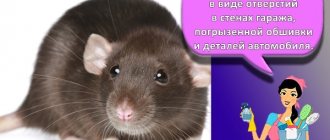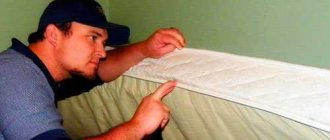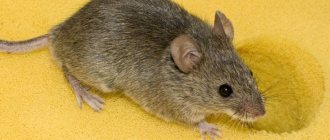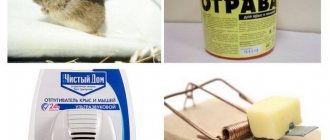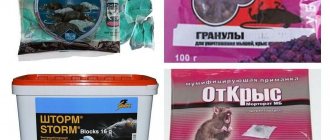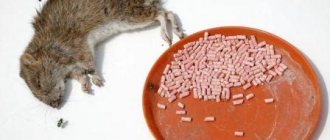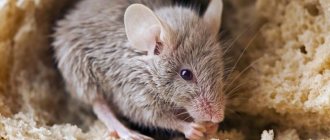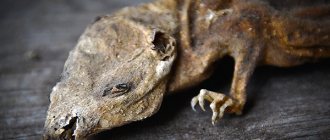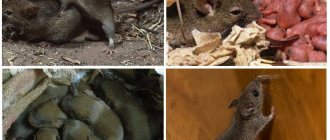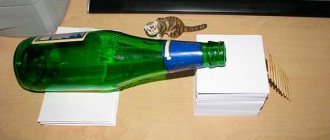The appearance of mice in a house, apartment or country house does not bring joy to the owners. These rodents are malicious pests of human property. Due to the special structure of their teeth, mice are constantly forced to chew on some objects. And these objects can be anything: wood, plaster, concrete, upholstery, plastic. Like all small animals, they love to feast on edibles. In addition, mice can be carriers of infections dangerous to humans. To fight them, you need to know what mice are afraid of.
Causes and consequences of rodents in the house
There is always food and warmth near a person - rodents have figured this out a very long time ago. Protection from the wind, some goodies - everything you need for a quiet life and reproduction. And pests are not picky when it comes to food; both dry cereal and oily rags are suitable for them. Nature has awarded individuals with incredible vitality and the ability to digest almost any food, including cellulose, cotton wool and other objects inedible for humans.
To get rid of mice, you first need to carry out prevention - assess the state of cleanliness, the presence of secluded nesting places and the likelihood of individuals entering from the outside. To understand why mice in the house are bad, you should familiarize yourself with the possible consequences of the neighborhood:
- Rodents are carriers of diseases such as plague, typhoid, rabies, and cholera.
- Pests are not only capable of destroying stocks of vegetables, cereals and other food, but can irrevocably spoil stored flour and pasta. If the mouse has left marks in the form of feces or urine, the food becomes contaminated and should not be consumed.
- Wires, power cables, casing, machinery and building materials are at risk. It is not difficult for a large mouse to gnaw a hole in concrete. Gnawed wires will lead to a short circuit, which causes a fire, and if pests get into the car, they can damage the mechanisms.
- Furniture, clothing, shoes are at risk - everything that might be of interest and could be eaten or chewed on. Gray animals will gladly tear a fur coat into pieces to line their nest.
- The smell of mice cannot be confused with anything else. This aroma lasts for a very long time, and as long as domestic mice live near humans, their smell cannot be removed.
Mice in the house make themselves known by black beads of feces, chewed bags, and an unpleasant odor. It is extremely rare to see them, but this only happens when there are many “neighbors”; usually rodents prefer to work and live secretly. If you find at least one gray pest, you need to urgently get rid of the mice. Otherwise the problems will soon become significant. One female vole can produce offspring over the summer that will fill a small country house. And here the gray mass will make itself felt by complete damage to property, vegetable gardens and garden plantings.
Why is it necessary to fight rats?
The main thing that should not be forgotten is that rats reproduce very quickly, so you need to start fighting them as quickly as possible. In a year, one female alone can bring about a hundred new small pests into your home. They cause significant damage to property, destroy and spoil food, and transmit many dangerous diseases. Imagine how much the damage caused by these rodents will increase if there are more and more of them in your home. And it will become much more difficult to get rid of them.
Traditional methods of getting rid of mice in the house
If there are grandparents in the family over the age of 70, they know exactly how to get rid of mice. In their years there was no Internet, therefore all methods were transmitted only by word of mouth and ineffective ones were eliminated during the transmission process. We offer the most effective folk remedies for mice that will help cope with the problem today:
- Natural repellents. These are herbs with a strong odor that is unpleasant to rodents. Suitable plants are tansy, wild rosemary, pyrethrum, wormwood. Place bunches of fresh plants in the corners, change them as they dry. Wormwood smoke helps well; they need to fumigate the room. A mixture of bay leaves and vinegar is also recommended. Pour a couple of laurel leaves with acetic acid, place bowls in the areas where rodents are located; mice cannot stand the strong smell and leave.
- Baits with poison. Flour, oat bran and other products are suitable as goodies. Mix with gypsum (1:1), place in cups under burrows or “on paths” for mice to pass through. You should also leave water in a visible place. After tasting the gypsum mixture, the mice will want to drink. It is not difficult to predict what will happen as a result - the plaster will harden in the stomach and there will be no mice. But such a bait only works once, social animals may not approach a treat with the same smell, and the appetizing component will have to be changed. If the option with plaster seems monstrous, finely chopped wine corks will help. You can also mix the fractions with food and put them on – the effect is the same. It is worth knowing that the method is aimed at significant extermination, so the dead carcasses will need to be collected, removed and burned.
- Traps. You can buy mousetraps or make your own. Add oil and some food to a wide-necked plastic bottle. The mouse needs to be able to get into the container, but not be able to get out. To get rid of mice, you need a lot of traps, empty them when they are full and set them again. The method is fail-safe; house mice climb into jars in droves.
- Strong chemical smell. Turpentine, formalin, kerosene - all these aromas frighten pests. You need to lubricate the seams of walls and baseboards generously, so this method is not suitable for residential premises.
- Uncomfortable travel conditions. Folk remedies for mice in this case offer a lot of options: sprinkle ash, red pepper, crushed glass on the baseboards. Contact of the exposed skin of the paws with substances causes pain, and rodents will also lick the ash and pepper, which will only aggravate the unpleasant effect.
- Glue trap. You need cardboard or a board, glue with a sufficient shelf life. You can take special glue or Moment, mixing in a little flour. Spread the cardboard with glue, place it in the area where the rodents are located - after a while, check the trap, refresh the glue or throw out the dead animal (it is better to burn it).
Traps are good for their effectiveness, but when rodents get into the cardboard, they make a lot of noise in the mousetrap. In addition, if there are mice in the house, then there may be a rat somewhere, and a mousetrap cannot contain it, so more powerful methods are needed.
The biological method is a cat. This is a natural enemy of rodents that works always and anywhere. But there are limitations here too:
- domestic cats have long lost their hunting skills and may themselves be afraid of mice, rather than catching them;
- kittens are not able to catch and kill an adult;
- Not even every adult cat can handle a rat;
- rodents respond by attacking and biting - this can cause illness in the pet;
- To get rid of mice, you need your own cat; someone else’s cat is unlikely to catch pests in an unfamiliar environment.
If it is not possible to have a cat, for example, at the dacha in the summer, you should feed your neighbor Murzik. A little affection and the cat will repay you by exterminating the entire mouse family in the vicinity. As a rule, village or rural cats do not hunt alone, so they can cope even with large individuals and numerous litters. This option is better than all folk remedies for mice.
Lethal electrical and mechanical traps
The classic mousetrap is still in demand. It's easy to make with your own hands. Electronic traps are becoming increasingly popular. They are more effective in fighting rodents and more humane than mechanical ones. An ordinary mousetrap sometimes injures the mouse and you have to finish it off, which is unpleasant.
When running into an electrical trap, an animal touches a metal part that is under electrical voltage and receives a fatal charge of current. Electronic traps usually have an indicator installed to indicate whether a mouse has been caught.
If mousetraps remain empty for several days, then they are not positioned correctly or they contain bait that does not attract mice. Traps are set near the habitat. As for taste preferences, rodents love cheese, sausage, bacon, and meat.
How to get rid of mouse odor
Dying from poisons, bait or falling into a trap, a large mouse can crawl into a secluded corner from where it is not possible to get it. And if the bait is generous, then the massive destruction will fill the house with the smell of disappearing carcasses. First, you need to clean the room as much as possible from rodents, inspect from the basement to the attic, from the pantry to the balcony. After removing and burning the rodents, begin cleaning.
How to get rid of the smell if there were mice in the house:
- Rinse floors, walls, furniture and ceilings with vinegar water. For 5 liters of warm water, take 6 tbsp. l. acetic acid. The essence will quickly eliminate all residual odors.
- After drying the surface, treat it with hydrogen peroxide. This is an antiseptic that destroys microbes, so there is no need to spare peroxide.
- If there are residual aroma, potassium permanganate will help. Dilute the crystals in water, achieving a pink color, and process the surfaces. Wear gloves on your hands to avoid burning your skin. The composition will kill germs and odors in hard-to-reach places; you need to take the liquid into a bulb or spray bottle and generously spray the cracks and joints. After drying, treat with peroxide.
Finally eliminates germs and bleach smell. Whiteness or regular chlorine soda will do. Dilute in water and rinse all surfaces, now the apartment is clean and free of germs. Sometimes house mice stomp on the suspended ceiling, leaving their marks there. To get rid of the smell, but not blur the surface, folk remedies for mice will help:
- whitewash the ceilings with lime and blue;
- add copper sulfate to the chalk white and whiten the base;
- dilute quicklime in water, add pure chlorine and a little blue – the composition kills all microbes.
Lime is a natural antiseptic, and when supplemented with chlorine or blue, it greatly enhances its properties.
Sound repellent
The person is very observant by nature. Over time, he began to notice what sound mice were afraid of. They, like any animal, are afraid of sharp and loud sounds. Periodic repetition of sudden sound effects will help get rid of rodents for a long time. In addition to short, sharp bangs, rodents indoors can be frightened by prolonged exposure to noise, such as playing loud music or using work tools for repairs.
Review
I want to tell you about my experience in fighting mice. There was a mouse in my house, rustling under the floorboards at night and gnawing on something. I decided to take the advice of my friends and started knocking loudly on the floor every time the mouse made itself known. At first, its activity became less frequent, and then the pest completely ceased to manifest itself in any way in my house.
Irina, Moscow
Modern ways to get rid of mice
Having figured out what house mice are afraid of, you can try all the methods in order or buy a mouse repeller. This is a universal remedy that helps get rid of mice in any room and in any quantity. For conservationists and anyone who does not want to deal with the removal and burning of carcasses, an ultrasonic repeller is the only possible option. There are many advantages of using:
- This is a humane way. The mouse repeller does not kill, but creates unbearable living conditions. The device operates on the principle of generating and transmitting a constantly changing audio track. In the understanding of rodents, a mouse repeller is a danger signal. The ear of a person and a pet does not hear sounds, but for pests it is the same as the roar of an airplane turbine right next to the ear. And the roar is not one-time, but constant and continuous. It is physically impossible to be in such conditions; the pests will go away on their own.
- No animal deaths. It turns out that mice do not appear in the house due to discomfort. They do not die in walls, thicker ceilings, under floors or suspended ceilings, they go away.
- There is no smell or other irritating effects. This property allows you to install devices in residential, non-residential premises, under a roof or on the ground. The basic rule is to select a module of the required power and calculate the installation area in advance.
- Harmless to all living beings. The ultrasonic repeller works inaudibly for humans, dogs, cats and other living creatures. A pet rat or other rodent may experience discomfort, but here you have to choose - hordes of gray pests or temporary inconvenience of your pet.
- No adaptation. Unlike bait, poison, or a mousetrap, an ultrasonic repeller cannot be bypassed and not fall under its influence. The device is reusable and is used both for prevention and to eliminate the problem.
- Mice will never appear in the house again. Preventative activation of the device is only necessary for apartments and houses located near granaries, trash cans, and other open food facilities. The regularity of room treatment is infrequent; a day's worth of cleaning will suffice after 2-3 months.
- Efficiency. The devices work 100% of the time. To expel a large population, you need to wait a little (2-3 days of continuous operation); if we are talking about large areas of elevators, then constant long-term operation of the devices will be required, but the repellers will drive out the mice forever.
To get rid of mice, you don’t need to collect wormwood, smear the walls with kerosene or scatter bait. In the latter case, there is a danger that the carcass will be eaten by a pet or a child will be injured while looking at a small mouse stuck to the cardboard. The price of repellers is higher than that of folk remedies, but the devices have been working for decades. And if you choose a battery-powered device, you can get rid of mice in chests and closets, in the garage, in the attic and anywhere there is no connection to the electrical network. If you don’t know what kind of unit you need, an experienced manager will help. Call, a specialist will select a device in accordance with the user’s needs and capabilities.
Chemical control agents
The most effective method of getting rid of mice is poison, but it is also the most dangerous. The market offers a large selection of various pesticides against rodents. They are sold in the form of powders, suspensions, solutions, briquettes and gels.
The principle of action of the poison is the same: it causes internal bleeding or disruption of organ function, which leads to death. After the first dose, the drug may not be fatal, so it is necessary to create conditions for unlimited access to it. Lures have a cumulative effect. The results may take some time to appear. It is important to remember that the poison is dangerous, so its use should be done without the presence of animals and people.
The most popular chemicals are:
- Krysin. Brodifacoum is used as a base. The drug does not deteriorate from sunlight and is not afraid of moisture, so it is convenient for use in sewers, basements and other places with an aggressive environment.
- Brodifan. Rodents don't recognize it. Used as bait. After eating the product, mice begin to suffocate and die.
- Varat. The active ingredient is brodifacoum. Blocks blood clotting and causes suffocation. Rodents die completely two weeks after consuming poison distributed in their habitats.
- Testox. Available in tablet form. Lay out along the perimeter of the room in 3 m increments. Particular attention should be paid to places where the greatest mouse activity is observed.
- Rat death. It also contains brodifacoum. Causes pests to feel dangerous, which forces them to leave the home. This eliminates the need to dispose of dead animals. When dying, mice do not go far from their habitats. Therefore, after the etching procedure, every day you need to check all rooms for the presence of corpses and dispose of them immediately. As they decompose, they emit a very unpleasant odor.
It is better to use pesticides in summer cottages when people have left them for the winter.
Poison - the best drugs
The poison has a good effect and copes well with rodents. Manufacturers produce it in the form of powder, special liquid, poisonous briquette, paste. The following brands have proven themselves well:
- "Rat Death No. 1." The poisonous mass has a pleasant aroma that rodents like. It releases fumes that are harmful to rats and have a depressing effect on the respiratory system of the pests. The maximum effect is achieved a week after treatment;
- "Goliath". The drug helps to poison a large number of rodents. Its effect does not begin immediately, but after a week. During this time, all pests eat the bait, which does not cause them any concern. Soon all the animals die;
- "Ratid 1". Helps poison rodents, used in all types of buildings;
- "Storm". The main advantage of the poison is the lack of decomposition of dead individuals. In this regard, there is no specific smell;
- "Nutcracker". The green briquette acts as bait. The rodent absorbs a poisonous mass that poisons the circulatory and respiratory systems. After a short period of time, suffocation develops, which forces the rodent to crawl out into open areas. A dead specimen is easy to locate and dispose of;
- "Tsunami". The tablet preparation is pink. Safe for pets and people. It has a cumulative effect, having a detrimental effect on the cardiac, nervous and circulatory systems of the rodent.
A poisoned mouse should not be handled with bare hands. You can throw out the pest using a dustpan, or wearing household gloves on your hands.
What else are pests afraid of?
The question of what smell repels rats and mice is puzzled by those who, for one reason or another, cannot use chemicals.
- Bleaching. The smell of this substance is actually avoided by mice and rats. However, one should also take into account the fact that when using this product in a residential area, the inhabitants of the home themselves will have to inhale its aromas.
- Vinegar. Has properties similar to bleach. Inhaling its vapors is also unsafe for humans.
- Naphthalene is a strong carcinogen, and therefore experts do not recommend using it in residential areas.
Who are pests afraid of?
Not all rodents are afraid of cats. The exception in this case is large pasyuki or gray rats. Many of them are able to move freely in broad daylight, without paying much attention to the mustachioed pet sitting next to them. However, there are also brave cats who are not afraid to attack uninvited guests. The dog easily attacks a large rat.
The cat will provide invaluable service in catching small parasites. Rodents are very afraid of even the cat smell that is present in the apartment. Having cleared the house of pests, many mustachioed predators go hunting in neighboring areas. Mice and rats are no less afraid of birds.
Rats versus mice are also a common occurrence in nature. Where large rodents have settled, small ones will never appear. After all, a hungry rat poses a serious danger to a little mouse. Rodents are also afraid of people, but in some cases rats can attack humans.
Essential oils
Another pest repellent is essential oils. Their concentrated odors are not liked by rats and mice. It is enough to place an oil-soaked swab or a piece of cloth next to the rodent's hole, which will smell strongly, and the mouse family will no longer live there.
Essential oils should be used with extreme caution, as their concentrated odor can cause an allergic reaction.
Plants against pests are used quite widely. However, rodents are repelled not only by herbal aromas. The smell of kerosene, burnt rubber and even perfume products is also detrimental to parasites. However, most of them are preferable for use in non-residential premises.
Table comparing the properties of the main thermal insulation materials
| Name of material | Thermal conductivity, W/m*K | Vapor permeability, mg/m*h*Pa | Moisture absorption,% | Flammability group |
| Minvata | 0,037-0,048 | 0,49-0,6 | 1,5 | NG |
| Styrofoam | 0,036-0,041 | 0,03 | 3 | G1-G4 |
| PPU | 0,023-0,035 | 0,02 | 2 | G2 |
| Penoizol | 0,028-0,034 | 0,21-0,24 | 18 | G1 |
| Ecowool | 0,032-0,041 | 0,3 | 1 | G2 |
Order high-quality insulation for your home right now from our company!
Reviews: real user experience
I'm telling my story. First floor - the mice were shaking. Mousetraps are not a solution for me - then I have to throw out the mice, I can’t. Poison - the problem is that a mouse can die anywhere - under a cabinet, for example. The smell, I’ll tell you, is still the same, but by the time you find where she died, you’ll have to turn the whole house over. There are also ultrasonic repellers, but they don’t have a license for how they affect people - I didn’t take the risk. I went the old-fashioned way and got a cat. He caught mice for 2 months without stopping, starting at the age of four months. The mice have disappeared, and the beloved cat is already 6 years old
Miki
https://www.woman.ru/home/medley9/thread/3872460/1/#m17552115
There is a special glue for rodents, we caught a whole family of mice in less than a week. You spread the glue on a small cardboard, in the middle of something tasty, mice come running at night and stick to each other, sometimes as many as three mice would stick together, dad would throw those caught along with the cardboard into a bag and into the trash or out the door, and throw them out in the morning. Animals should not be allowed into the room where there is cardboard with glue.
Dina-na
https://www.woman.ru/home/medley9/thread/3872460/1/#m17573424
I haven’t tried ultrasound, I don’t know how it works. But my parents periodically got mice at their dacha. Mousetraps weren't very helpful. Only poison. Inhumane, yes. But effective.
Marina_Alexandrova
https://forum.domik.ua/kak-izbavitsya-ot-myshej-v-dome-t30164.html#p1226880
He set up cheap mousetraps. Very easy to use, more convenient than classic wooden ones. I caught 3 mice in a day (by the way, there were no false alarms or misfires in the mousetraps; 3 clicks = 3 mice). No more mice have been observed yet. He put bread soaked in sunflower oil in mousetraps.
kurOK
https://forum.info-lan.ru/lofiversion/index.php/t13434.html
If you set up a homemade “multi-charged” mousetrap, all the mice will be there. Unfortunately, the industry doesn’t produce these, but you can easily make them yourself from a fifty board. 100% lethality. The number of mice caught per week according to your wishes. The good thing about mechanical mousetraps is that you can see how many mice are being hatched. Mouse poison neutralizes the process of defeating rodents, because There is no count of enemy losses. The scale of the victory is unclear.
Taxmen
https://www.e1.ru/talk/forum/go_to_message.php?f=120&t=386831&i=386923
Using the contents of the kitchen cabinet
Even in the kitchen cabinet you can find simple means for removing rodents. The most common varieties used in cooking are presented and described here. They are found in almost every kitchen.
Carnation
Cloves are the dried flower buds of evergreen plants with red and white flowers. The buds must be harvested at the right time, and it takes between 4,000 and 7,000 buds to produce one pound of cloves. The aroma of this plant is comparable to tobacco, as it has a bright, interesting smell. If you set fire to a dry clove, the smoke from it will scare away harmful rodents, insects, and blood-sucking parasites.
Coriander or cilantro
The term "coriander" is often used to refer to a spice made from the dried fruit of the Coriandrum sativum plant. This herb is also called cilantro or Chinese parsley. The fruits, or seeds, are small and round, brown or tan in color. They are sometimes called coriander or coriander seeds. Cilantro leaves have a spicy taste and aroma that often causes extreme reactions. People either love him or hate him. Small animals react very negatively to coriander.
Chilli
Chili peppers are in the line of vegetables with garlic, onions, and peppers. Among them, it is the most caustic, pungent, and bright in both taste and aroma. Its strength and hardness are not inferior to vinegar or ammonia. Small and large animals, rodents, insects, and even people cannot stand such a specific smell. It can be used in any form - fresh, dried.
Sage
Sage is an herb with oblong gray-green leaves that are used in cooking and herbal medicine. The herb emits a pungent, slightly astringent odor. Fresh leaves are usually used, although it is one of the few herbs that actually has a more intense and concentrated flavor when dried. If you buy dried sage, you should store it in a cool, dark place in an airtight container to preserve its specific properties. Growing sage is relatively easy. It will thrive in most environments as long as it is in sunny, well-drained soil. Small animals do not like its aroma.
Homemade baits
Homemade baits will help you catch a mouse without a mousetrap:
- The bottom of a transparent container should be spread with chocolate paste. Turn the trap upside down and place one side on the edge of the coin. When the mouse sneaks under the trap, wanting to eat the treat, the balance will be upset. The container will cover the pest and will not allow it to get out;
- using a jar or aquarium. It is necessary to place edible bait at the bottom of the trap. Attach a homemade ladder from a stack of books or magazines to a jar or aquarium. Once trapped, the pest will not be able to escape, since glass is a slippery material.
Caught rodents should not be handled with bare hands. It is necessary to throw a thick cloth over them and take them away from the living space.
Preventive control measures
Instead of looking for effective methods to kill rodents, it is better to prevent their appearance. To do this, you need to take the following measures:
- Maintain hygiene: maintain cleanliness, do general cleaning regularly, do not leave dirty dishes, take out the trash on time;
- attach a fine grille to the entrances to the ventilation pipes so that rodents cannot enter the home through them;
- be sure to seal all the cracks and holes in the house with cement mortar and perform a high-quality sealing of the plumbing system;
- eliminate possible sources of standing water or close them to prevent rodents from accessing them;
- store food in glass, iron or other sealed containers with tight-fitting lids;
- paper, cotton wool, pieces of cloth are building materials for mouse nests, so they should be inaccessible;
- mice love to live in closets and chests of drawers, it is advisable to check them sometimes;
- To reduce the likelihood of rodent attacks, before the onset of cold weather, you need to inspect the area around the house for the presence of mouse nests and burrows.

